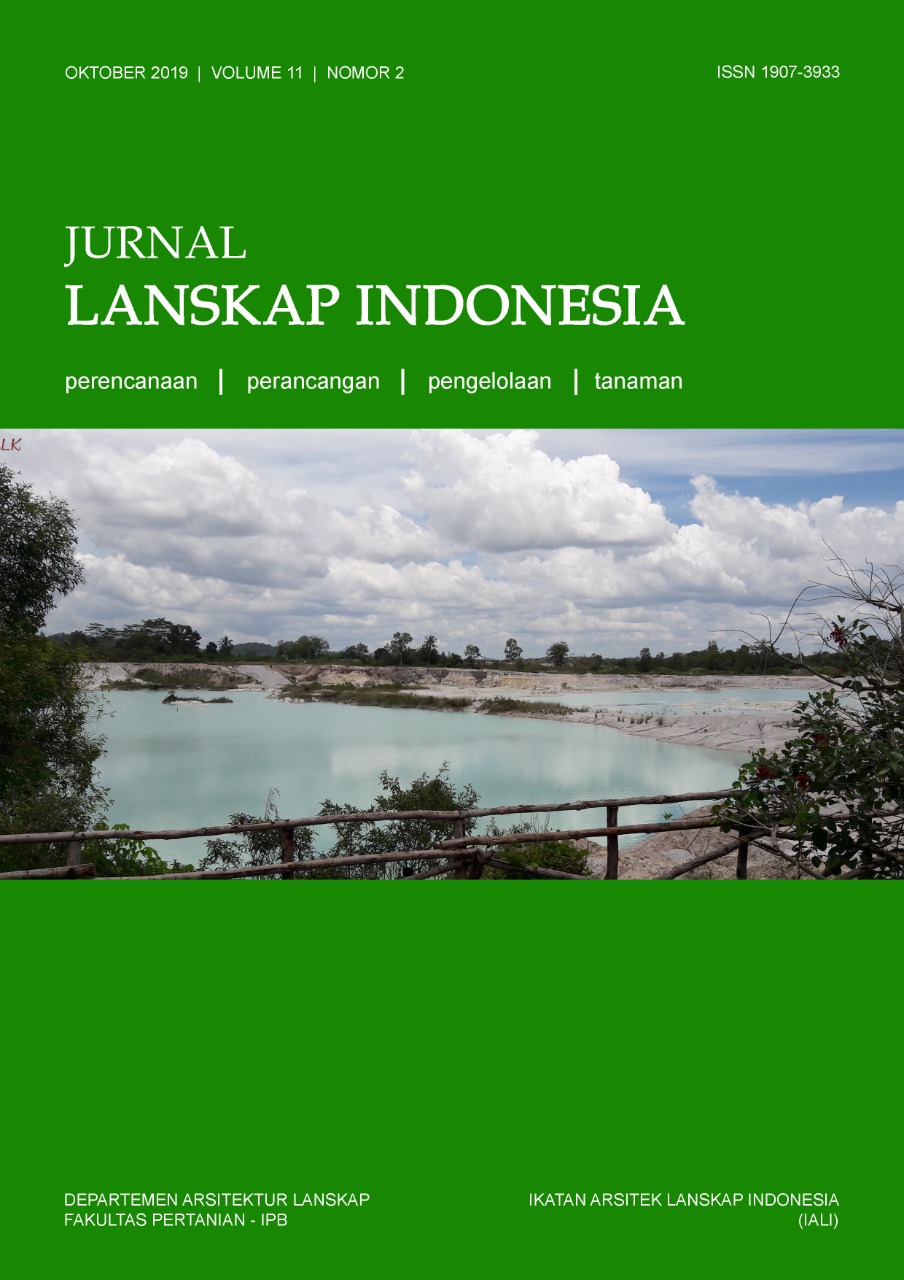Ecological Value of Cemetery in Jakarta
Abstract
Cemetery Parks currently have a highly demand by urban community. The fact that settlement competing with the park. The study of green open space of cemetery was relatively limited to be observed. The objective of the study was to determine the potential of Cemetery Parks in absorbing carbon. The research was conducted in Tanah Kusir and Kampung Kandang cemetery parks. The methodology employed applied to Quadran typology. The balanced ecological assessment for both parks showed that the carbon absorbtion demonstrating significant results. And related trees as for Glodogan (Polyathea longifolia), Rambutan (Nephelium lappaceum) and Tanjung (Mimusops elengi), achieving gradual levels of carbon absorbtion.
Downloads
References
References
Department of City Park and Cemetery DKI Jakarta Province, (2014). Garden Booklet of Jakarta. Jakarta, Indonesia: Government of DKI Jakarta Province.
Department of Parks and Cemeteries South Jakarta Administration City. (2015). Number of Trees in Park Cemetery. Jakarta, Indonesia: Government of DKI Jakarta Province.
Fahlevi, Syam Rezza. (2013). Perancangan Ulang Kawasan Pemakaman Umum Tanah Kusir Jakarta sebagai Salah Satu Bentuk Pemanfaatan Ruang Terbuka Hijau Ramah Burung [Design Re-Zone Tanah Kusir Public Cemetery Jakarta as One form of Green Open Space Utilization Bird Friendly]. Bogor, Indonesia.
Putri, R. Agustina. (2013). Studi Tanaman Penghijauan Glodogan Tiang (Polythea longifolia), Kasia Emas (Cassia Surattensis), Kelapa (Cocos nucifera) sebagai Penyerap Emisi Gas Karbondioksida di Jalan PB. Sudirman Denpasar [Greening Plant Studies Glodogan Tiang (Polythea longifolia), Kasia Gold (Cassia Surattensis), Coconut (Cocos nucifera) As Absorbing Carbon dioxide Emissions in PB. Sudirman Street, Denpasar] E-Jurnal Agroekoteknologi Tropika, 2 (2), 108-115.
Priharyaningsih (2016). Pengembangan Ruang Terbuka Hijau Pemakaman di Perkotaan Studi di Jakarta Selatan [Development of Open Space in Urban Green Cemetery. Case Study: in South Jakarta)] Jakarta, Indonesia: Universitas Indonesia.
Rahayu, S. (2015). Optimalisasi Fungsi Peranan Taman Kota (Kajian di Taman Kota Menteng, Jakarta Pusat) [Optimizing the Role Function State Parks (Studies in Park City Menteng, Central Jakarta)]. Jakarta, Indonesia: Universitas of Indonesia.
Samsoedin, I., & Wibowo, A. (2012). Analisis dan Kontribusi Pohon di Perkotaan dalam Menyerap Gas Rumah Kaca Studi kasus: Taman Kota Monumen Nasional, Jakarta [Potential Analysis And Contributions Trees in Urban Absorb Greenhouse Gases. Case study: Monumen Nasional Park Jakarta] Social and Economic Research Journals Forestry , 9 (1), 42-53.
Statistical Central Bureau. (2016). South Jakarta in Figures 2016. Jakarta, Indonesia.
Villanueva, K., Badland, H., Hooper, P., Koohsari, J., Mavoa, S., Davern, M., Roberts, R., Goldfeld, S., & Corti, B. (2015). Developing indicators of public open space to promote health and wellbeing in communities. Applied Geography. 57, 112-119.
Women and Community Empowerment Board to Family Planning. (2015). Performance Optimization Program Manager Family Planning to Achieve a prosperous new Jakarta. Jakarta, Indonesia.
Yunus, H. (2000). Urban Spatial Structure. Yogyakarta, Indonesia: Pustaka Pelajar.
This journal permits and encourages authors to post items submitted to the journal on personal websites or institutional repositories both prior to and after publication, while providing bibliographic details that credit, if applicable, its publication in this journal. However, after the article is submitted and published in this journal, it is fully copyrighted by the Jurnal Lanskap Indonesia or JLI. If excerpts from other copyrighted works are included, the author must obtain written permission from the copyright owner and give credit to the source in the article. Then, the writer or reader is allowed to copy, share, and redistribute articles/material in any form. But it must still include the appropriate source and credit because the article in this journal is licensed by Creative Commons Attribution 4.0 International License (CC BY 4.0).
I. Proposed Policy for Journals That Offer Open Access
Authors who publish with this journal agree to the following terms:
- Authors retain copyright and grant the journal right of first publication with the work simultaneously licensed under a Creative Commons Attribution License that allows others to share the work with an acknowledgement of the work's authorship and initial publication in this journal.
- Authors are able to enter into separate, additional contractual arrangements for the non-exclusive distribution of the journal's published version of the work (e.g., post it to an institutional repository or publish it in a book), with an acknowledgement of its initial publication in this journal.
- Authors are permitted and encouraged to post their work online (e.g., in institutional repositories or on their website) prior to and during the submission process, as it can lead to productive exchanges, as well as earlier and greater citation of published work (See The Effect of Open Access).
II. Proposed Policy for Journals That Offer Delayed Open Access
Authors who publish with this journal agree to the following terms:
- Authors retain copyright and grant the journal right of first publication, with the work after publication simultaneously licensed under a Creative Commons Attribution License that allows others to share the work with an acknowledgement of the work's authorship and initial publication in this journal.
- Authors are able to enter into separate, additional contractual arrangements for the non-exclusive distribution of the journal's published version of the work (e.g., post it to an institutional repository or publish it in a book), with an acknowledgement of its initial publication in this journal.
- Authors are permitted and encouraged to post their work online (e.g., in institutional repositories or on their website) prior to and during the submission process, as it can lead to productive exchanges, as well as earlier and greater citation of published work (See The Effect of Open Access).



























